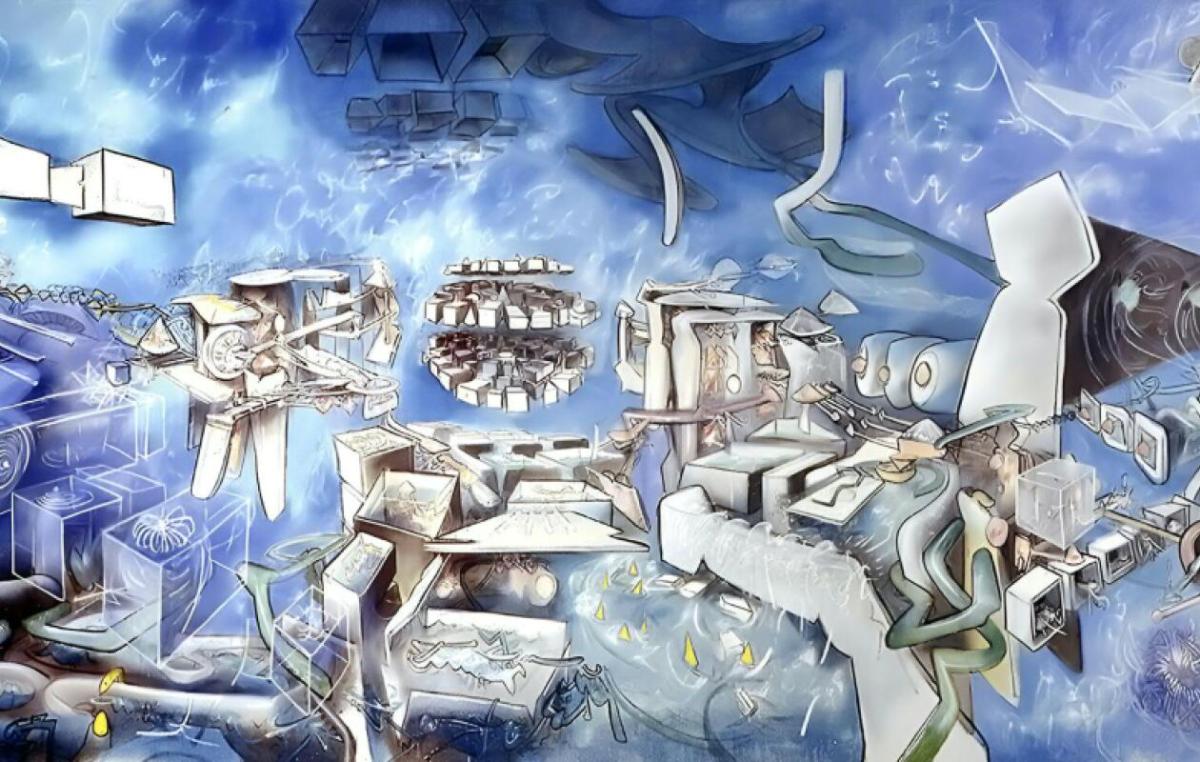Futuristic structures reminiscent of machines float against a strong blue background; Cube-shaped structures spread across a ten-by-four-metre area in the monumental work of Chilean painter Roberto Mata, extend into the room: “Coïgitum” is science fiction, abstract, and representational at the same time – and is the focus of the “Matta” exhibition at Kunstforum Wien. The first retrospective in Austria in more than 30 years opens on February 24.
“You won't get a photo like this from any museum anymore,” confirms director and curator Ingrid Brügger during a tour with the APA. “Because it's difficult to move. We rolled it and had up to 15 people hanging it.” She comes from the countryside Villa Matta near Rome and has never left the studio. In the upper hall of the Art Forum, the work has a hypnotic effect: is it an underwater world? outer space? nightmare? At the same time, it represents Mata's diverse and distinctive work.
Brugger asserts that “rediscovering one of the most important artists of the twentieth century in the mirror of the present” was their curatorial concept. Mata, born in Santiago de Chile in 1911 and died in Italy in 2002, trained as an architect. In 1933 he left his homeland and began painting. Salvador Dali encouraged him to continue his artistic work. One of the most formative experiences was an encounter with Pablo Picasso during Matta's work as the Spanish painter's assistant at the Universal Exhibition in Paris in 1937. “Then he threw the architect away,” Brugger smiles.
Matta was a self-taught painter, and like many Surrealist artists, he went to New York. Brugger says that seeing his artistic development solely focusing on Surrealism or Abstract Expressionism is “not enough.” Remaining alone, Mata “never surrendered to any fashion”, experimented with radically new spaces that depicted an alternative spatio-temporal reality. “He was very conservative with his art,” the museum curator explains. For example, stage design renderings for “The Magic Flute” were found on the property, which can now be seen publicly for the first time on Kunstforum.
Matta was a visionary, Brugger enthuses, pointing to a futuristic image in the show: “He painted space junk in the early 1940s — long before space travel.” Even then, he was pioneering avant-garde work on a very large scale. The retrospective also honors Matta's political and socially critical commitment; A painting depicting soldiers as pigs, which not only has a similar color to Picasso's “Guernica”, but also takes a stance on Pinochet's coup. It could also be satirical: Matta painted “La Banale de Venise” in 1955 “after the old Surrealists had been awarded their life's work at the Biennale. He saw it as pandering to the establishment,” Brugger explains.
The trained architect's sense of space can be admired in the installation of a painting by Matta from the early 1970s that has been recreated at the Kunstforum. The triptych takes a central position, depicting the coexistence of organic and technical forms. In addition, the tilted paintings – some suspended from the ceiling – float in the hall, casting shadows and playing with light: “Matta gives painting a new dimension,” says Brugger.
Matta also referred to his images as “cosmic ribbons.” Author Natascha Gangl and electronic music duo Rdeča Raketa have set a selection of paintings to short radio plays. Therefore the slogan is: “Bring your headphones to the exhibition hall!”
(Service – “Matta” at Austria Bank Kunstforum Vienna, 24 February – 2 July 2024, daily from 10 am to 7 pm, open on public holidays, photo study “Matta-log” in English for 39 euros, www.kunstforumwien. in)

“Travel aficionado. Certified problem solver. Pop culture guru. Typical writer. Entrepreneur. Coffee trailblazer.”







More Stories
Sylvia Schneider in Ireland is on the Halloween trail
»Festival de la Chasse«: a gastronomic event about fishing and regional cuisine
Salma Hayek's strategy for staying financially independent